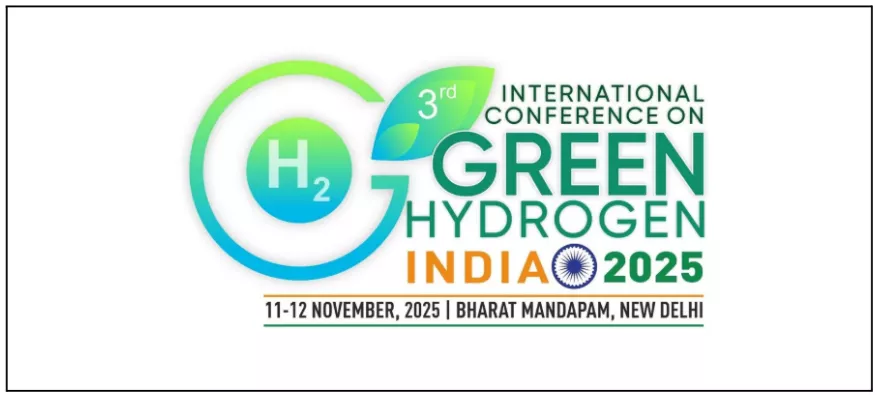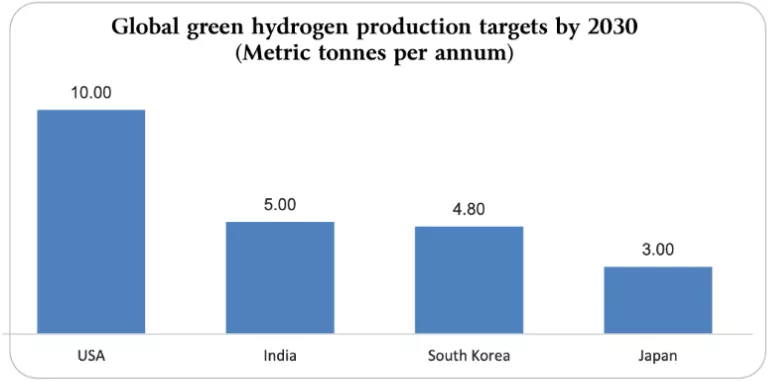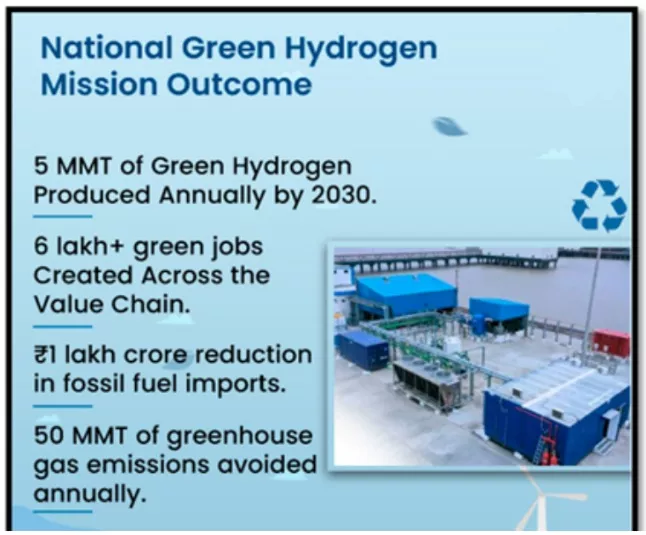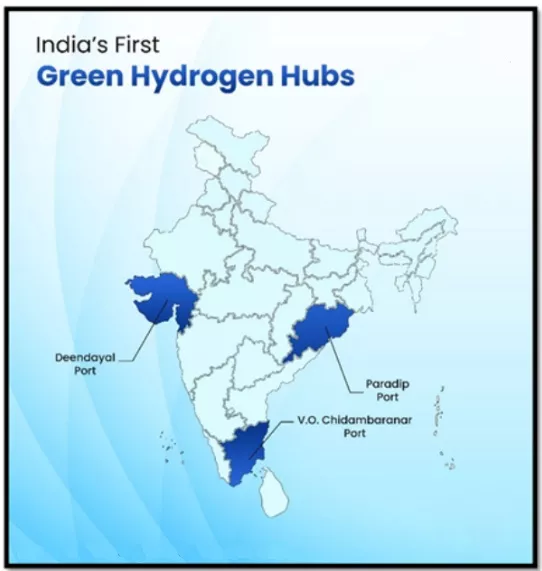Union Minister of State (Independent Charge) for Science and Technology addressed the 3rd International Conference on Green Hydrogen (ICGH–2025) at Bharat Mandapam, New Delhi.
Key Initiatives Highlighted by Minister in ICGH-2025

- Four Hydrogen Valley Innovation Clusters (HVICs) Across India Announced
- Conceptualized by Department of Science and Technology (DST) and now integrated under Ministry of New and Renewable Energy (MNRE)’s National Green Hydrogen Mission (NGHM).
- Significance: They are designed to showcase India’s first large-scale hydrogen demonstration projects.
- They serve as living laboratories for innovation, standardization, and policy development.
- Objective: Four Hydrogen Valleys are being developed across the country to demonstrate the full hydrogen value chain from production and storage to transport and utilization.
- Total investment: ₹485 crore, including:
- ₹169.89 crore under the National Green Hydrogen Mission (NGHM)
- ₹315.43 crore from industry and consortium partners
- Major R&D Boost Through the ₹1 Lakh Crore RDI Scheme:
- The Research, Development & Innovation (RDI) Scheme, launched in November 2025, marks a major structural shift.
- Corpus: ₹1 lakh crore, with ₹20,000 crore allocated to DST
- Aim: The scheme aims to strengthen deep-tech and clean energy innovation while encouraging active participation from startups and industry.
- Policy Shift: Initiative represents a shift from government-driven funding to a more collaborative, sustainable model that ensures long-term scientific and economic resilience.
- Institutional Integration Through the Anusandhan National Research Foundation (ANRF)
- ANRF is highlighted as a landmark reform.
- Statutory Body: Established under the Anusandhan National Research Foundation Act, 2023.
- ANRF acts as an apex body to provide high-level strategic direction to the scientific research in the country.
- Nodal Ministry: Ministry of Science and Technology.
- Precursor: Precursor: Replaces the Science and Engineering Research Board (SERB).
- Function: To fund, promote, and coordinate research and innovation across academic institutions, R&D labs, and industries.
- MAHA-EV Mission Strengthening Indigenous Hydrogen & Mobility Technologies
- MAHA-EV (Mission for Advancement in High-Impact Areas – Electric Vehicle): Advances indigenous batteries, fuel cells, EV components, and hydrogen-based mobility.
- Supports development of scalable charging and hydrogen refuelling infrastructure.
- Reinforces Atmanirbhar Bharat in green mobility.
- Mission Innovation 2.0: Mission Innovation” was first coined by Prime Minister Narendra Modi.
- Under Mission Innovation 2.0, India is working with international partners to reduce the cost of clean hydrogen to USD 2 per kilogram and to replicate its Hydrogen Valley model globally by 2030
- India’s Position in the Global Hydrogen Transition: India is projected as a key driver of the global shift toward a self-reliant hydrogen economy.
- Clean energy is now framed as an economic, technological, and strategic imperative, not merely an environmental choice.
- India aims not just to adopt but to invent and lead in hydrogen technologies.
About Green Hydrogen
- It is produced using renewable energy, such as solar or wind power, instead of fossil fuels.
- Hydrogen made this way is considered “green” if the total emissions from the process are very low, not more than 2 kg of CO₂ equivalent for every 1 kg of Hydrogen produced.
 Green Hydrogen can also be produced by converting biomass (like agricultural waste) into hydrogen, as long as emissions remain below the same limit.
Green Hydrogen can also be produced by converting biomass (like agricultural waste) into hydrogen, as long as emissions remain below the same limit.- How is Green Hydrogen Produced?
- Green hydrogen production relies on electrolysis, a process in which water (H₂O) is split into hydrogen (H₂) and oxygen (O₂) by applying an electric current through an electrolyzer using renewable energy, while grey hydrogen requires carbon combustion.
- Key factors in its production include:
- Electrolyzers: Devices that split water molecules into hydrogen and oxygen.
- Renewable Energy Sources: Solar, wind, and hydropower provide the necessary electricity for electrolysis, ensuring zero carbon emissions.
- Water Resources: Sufficient water supply is required, as one ton of hydrogen production needs approximately nine tons of water.

Types of Hydrogen (Refer Image)

Significance of Green Hydrogen
- Zero Carbon Emissions: Green hydrogen is produced using renewable energy sources, emitting only water vapor as a byproduct, unlike fossil fuels that release large amounts of CO₂.
- Example: Replacing 1 kg of grey hydrogen (emits 9 kg CO₂) with green hydrogen can reduce significant carbon emissions in sectors like refining and ammonia production.
- Versatility Across Sectors: Green hydrogen can replace fossil fuels in hard-to-abate sectors like steel, cement, fertilizers, shipping, and aviation.
- Example: The steel industry, a major fossil fuel consumer, can adopt green hydrogen to produce green steel, reducing emissions by up to 90% compared to traditional methods.
- Use in Agricultural Sector: Green hydrogen can decarbonize the agriculture sector by replacing natural gas-derived grey hydrogen in fertilizer production, reducing carbon emissions significantly.
- Example: Green hydrogen can produce ammonia, a key fertilizer component, while ensuring sustainability and reducing dependency on fossil fuels.
- Energy Independence and Security: Reduces reliance on imported fossil fuels, enhancing energy security for countries with abundant renewable resources.
- Example: India, with an annual energy import bill of $185 billion, aims to save ₹1 lakh crore by 2030 through green hydrogen adoption under the National Green Hydrogen Mission.
- Sustainable Transport Solutions: Green hydrogen powers fuel cells in heavy-duty vehicles, ships, and trains, providing a clean alternative to diesel and natural gas.
- Example: Japan’s development of hydrogen-powered trains and India’s pilot hydrogen-fueled buses by NTPC in Leh and Noida.
- Long-term Energy Storage: Hydrogen allows renewable energy storage for long durations, overcoming the intermittency of solar and wind power, unlike fossil fuels that are finite.
- Example: Hydrogen storage solutions are being tested to stabilize grids in Europe and the U.S., ensuring reliable energy during high demand periods.
- Potential for Global Trade and Export: Countries with renewable energy surplus can produce green hydrogen for export, creating economic opportunities and reducing global dependence on fossil fuels.
- Example: Australia-Japan’s Hydrogen Energy Supply Chain project aims to export green hydrogen to meet Japan’s decarbonization targets.
|
National Green Hydrogen Mission (NGHM)

- Objective: Make India a global hub for green hydrogen production, use, and export.
- Key Targets:
- 5 MMT annual green hydrogen production by 2030.
- Add 125 GW renewable energy capacity for hydrogen production.
- Save ₹1 lakh crore in fossil fuel imports and reduce 50 MMT CO₂ emissions annually.
- Mission is expected to create over 6 lakh jobs, reduce fossil fuel imports by more than ₹1 lakh crore, and avoid nearly 50 MMT of greenhouse gas emissions every year by 2030.
Sectoral Innovation & Implementation Under NGHM
- Mission focuses on four key pillars, including policy and regulatory framework, demand creation, research and development & innovation, and enabling infrastructure and ecosystem development
- Sub Schemes under the NGHM:
- Strategic Interventions for Green Hydrogen Transition Programme (SIGHT): A financial incentive mechanism with an outlay of ₹ 17,490 crore up to 2029-30 provides incentives for the manufacturing of electrolysers that are used for production of green hydrogen.
 It aims to support 4GW of domestic electrolyser manufacturing capacity and assist production of 1 million tonnes of green hydrogen by 2030.
It aims to support 4GW of domestic electrolyser manufacturing capacity and assist production of 1 million tonnes of green hydrogen by 2030.
- Development of Green Hydrogen Hubs: In October 2025, the Ministry of New and Renewable Energy (MNRE) announced the recognition of three major ports as Green Hydrogen Hubs under the NGHM
- Three Major Ports: Deendayal Port Authority (Gujarat), V.O. Chidambaranar Port Authority (Tamil Nadu), and Paradip Port Authority (Odisha).
- These coastal gateways will serve as integrated centres for production, consumption, and future export.
- Green Hydrogen Hubs: States and regions capable of supporting large scale production and/or utilization of hydrogen will be identified and developed as Green Hydrogen Hubs.
- Green hydrogen projects planned in Gujarat, Odisha, and Tamil Nadu.
NGHM Applications Across Industry, Mobility, and Infrastructure
- Industrial
- Fertilizers: Replacing fossil-fuel-based feedstocks with Green Ammonia.
- Recent auction for a long-term supply of green ammonia to fertilizer units, with an aggregate procurement capacity of 7.24 lakh metric tonnes per annum,at a price of ₹55.75 per kg.
- Petroleum Refining: The Mission is seamlessly facilitating the replacement of fossil-based hydrogen with green hydrogen in refineries, directly reducing the carbon footprint of this essential industry.
- Steel: Five pilot projects have been initiated in collaboration with public and private steel producers to evaluate the use of Green Hydrogen for iron reduction and other process applications.
- These pilots are designed to assess the technical feasibility, economic viability and safety of hydrogen-based steelmaking in Indian operating conditions.
- Mobility and Transport
-
- Road Transport: In March, five major pilot projects were initiated involving 37 hydrogen vehicles (buses and trucks), and 9 refueling stations across 10 different routes.
- Shipping: A port-based Green Hydrogen Pilot Project was commissioned at V.O. Chidambaranar Port in September 2025 featuring the 10 Nm³/hr facility that will supply green hydrogen for applications such as street lighting and an EV charging station.
- Deendayal Port Authority, Kandla has commissioned a megawatt-scale, indigenous Green Hydrogen Facility with an annual production capacity of nearly 140 metric tonnes.
- 750 m³ Green Methanol Bunkering and Refuelling Facility is being developed to support cleaner maritime operations and establish a Coastal Green Shipping Corridor between Kandla and Tuticorin.
- High-Altitude Mobility: NTPC in November 2024 was commissioned the world’s highest altitude(3,650 m) Green Hydrogen Mobility Project in Leh, which includes 5 hydrogen intra-city buses and a fuelling station proving the fuel’s reliability in extreme conditions.
- This station shall mitigate the carbon emissions of approx. 350 MT/year and contribute 230 MT/year of pure oxygen into the atmosphere which is equal to planting of approx. 13000 trees.
- Enabling Framework: Beyond direct incentives, a comprehensive enabling framework is being established to de-risk investments and accelerate development.
-
- Policy Framework: To facilitate the delivery of low-cost renewable energy for hydrogen production, the government has provided a waiver of Interstate transmission charges and ensured a time-bound grant of Open Access.
- Skill Development: A coordinated skill development programme is being implemented, which has already led to the certification of more than 5,600 trainees in hydrogen-related qualifications, building a future-ready workforce.
International Collaborations
- World Hydrogen Summit: In 2024, India made its debut in the international hydrogen community at the World Hydrogen Summit in Rotterdam with the inauguration of its first India Pavilion.
- This positions India as a prime partner for global investment, and key partner in the emerging global hydrogen economy.
- EU-India Collaboration: Under the EU-India Trade and Technology Council, collaboration is expanding, with over 30 joint proposals received on hydrogen production from waste.
- India-UK Partnership: A dedicated Standards Partnership Workshop in 2025 was held to strengthen cooperation on hydrogen standardization
- Focus On: Safe, scalable, and globally harmonized Regulations, Codes and Standards (RCS) to enhance trade.
- Partnership with H2Global: In 2024, Solar Energy Corporation of India (SECI) signed an MoU with Germany’s H2Global Stiftung to collaborate on market-based mechanisms and joint tender designs, facilitating the export of Indian green hydrogen to international markets.
- Singapore: In 2025, Sembcorp Industries signed MoUs with V.O. Chidambaranar and Paradip Port Authorities to develop integrated green-hydrogen and ammonia hubs for production, storage and exports.
|
Challenges to Green Hydrogen Production
- High Cost of Producing Green Hydrogen: The cost of producing green hydrogen depends on two critical factors which make the production of green hydrogen expensive:
- Levelised Cost of Electricity (LCOE): It is the average cost of generating renewable electricity over a project’s lifetime.
- A higher LCOE directly increases green hydrogen production costs, as renewable electricity is the primary input for its production.
- Currently, there is a substantial disparity between green hydrogen production costs ($5.30–$6.70 per kg) and traditional grey/blue hydrogen production costs ($1.90–$2.40 per kg).
- Electrolyzer Costs: Electrolyzers are devices used to split water into hydrogen and oxygen through electrolysis.
- These systems rely on advanced technology, but due to relatively low demand, the cost of electrolyzers remains high.
- Alkaline electrolyzers cost approximately $500–$1,400 per kilowatt (kW).
- Proton Exchange Membrane (PEM) systems are even more expensive, ranging from $1,100 to $1,800 per kW.
- High Borrowing Costs: The cost of capital, particularly in developing markets like India, is often high.
- Studies show that a rise in weighted average cost of capital (WACC) from 10% to 20% can increase the cost of hydrogen by up to 73%.
- Since investment costs contribute 50–80% of the LCOE in renewable energy projects, even a small increase in WACC can significantly drive up production costs.
- Infrastructure Limitations: Lack of pipelines, storage facilities, and hydrogen refueling stations for transport and industrial use.
- Currently, India has only a couple of operational hydrogen filling stations, in Faridabad and Gurugram, insufficient for scaling adoption.
- Energy and Water Demand: Electrolyzers consume 9 liters of water per kg of hydrogen, creating challenges in water-scarce regions.
- Dependence on freshwater resources limits scalability, making seawater electrolysis an underdeveloped alternative.
- Storage and Transportation Challenges: Hydrogen is highly flammable and requires high-pressure tanks or cryogenic temperatures for storage and transport.
- Liquid hydrogen storage requires temperatures below −252.8°C, which involves expensive cryogenic infrastructure.
- Lack of Standardization and Certification: Absence of harmonized global standards for hydrogen production, carbon intensity, and safety protocols.
- Divergent definitions of “green hydrogen” allow biomass-based hydrogen, which still emits some carbon, to qualify.
- Dependence on Fossil Fuels in Energy Grid: Risk of using coal-dominated grids for electrolyzer operation when renewable energy is unavailable (e.g., at night).
- India’s grid relies on 70% coal-based electricity, which undermines the carbon neutrality of green hydrogen projects.
- Nascent Technology and Workforce Skills: Need for R&D in efficient, low-cost electrolyzers and non-freshwater-based production methods.
- Workforce skill gap in hydrogen production, storage, and infrastructure development.
- The ministry of skill development and education (MSDE) estimates a demand for 2.83 lakh jobs in production and storage, along with 11,000 roles in electrolyser manufacturing by 2030 for green hydrogen production units.
- Competing Renewable Energy Needs: Diversion of renewable energy from grid decarbonization to green hydrogen production could slow progress toward overall energy transition goals.
- India’s 2030 green hydrogen plan requires 125 GW of additional RE capacity, over and above the 500 GW target under the Paris Agreement.
Way Forward for Green Hydrogen in India
- Comprehensive Policy Framework: Develop a comprehensive policy framework extending beyond production incentives to address financing barriers.
- Introduce long-term hydrogen purchase agreements and partial loan guarantees to reduce investor uncertainty.
- Establish “regulatory sandboxes” to experiment with new business models safely and efficiently, drawing from fintech innovations.
What is a Regulatory Sandbox (RS)?
- It refers to a live testing environment where new products, services, processes, and business models may be deployed, on a limited set of users, for a specified period of time, with certain relaxations as per the provisions of the Telecommunication Act 2023.
- Purpose: The sandbox allows the regulator, the innovators, the service providers and the customers to conduct field tests and collect evidence on the benefits and risks of new product innovations, while carefully monitoring and containing their risks.
|
- Innovative Financing Mechanisms: Indian banks should adopt non-traditional financing structures tailored to hydrogen’s unique challenges, such as uncertain demand and long project timelines.
- Modular project financing could allow phased scaling of facilities, reducing upfront capital requirements.
- “Anchor-plus” financing models can secure base capacity investments from industrial customers, with flexible instruments financing additional capacity.
- Equipment leasing for electrolyzers can transform prohibitive upfront costs into manageable operational expenses, replicating the success of solar and wind sectors.
- Focus on Pilot Projects and Cost-Effective Business Models: Launch early projects in industrial hubs that integrate financial structuring and demonstrate cost-viable business models.
- Emphasize delivering green hydrogen at competitive prices for industries like steel and ammonia production.
- Infrastructure Development: Establish hydrogen hubs with integrated production, storage, and distribution systems.
- Develop pipelines, refueling stations, and other logistics to facilitate large-scale adoption.
- Establish localised industrial clusters in states like Odisha, Maharashtra, and Gujarat to promote regional self-sustaining hydrogen corridors.
- Promote R&D and Skill Development: Invest in indigenous technologies for electrolyzers and alternative hydrogen production methods.
- Launch training programs to build a skilled workforce for hydrogen production and infrastructure management.
- Encourage International Collaboration: Forge partnerships with key importing countries like Japan and the EU for technology transfer, market access, and export facilitation.
- Carbon Pricing and Disincentives for Fossil Fuels: Introduce carbon pricing mechanisms to make green hydrogen competitive and phase out grey hydrogen in industrial sectors.
Conclusion
Green hydrogen stands at the center of India’s clean energy strategy, driving the shift toward a low-carbon and self-reliant economy. Building on one of the world’s most competitive renewable energy bases, the National Green Hydrogen Mission is expanding domestic production, scaling innovation, and opening global markets for green hydrogen and its derivatives.
![]() 14 Nov 2025
14 Nov 2025


 Green Hydrogen can also be produced by converting biomass (like agricultural waste) into hydrogen, as long as emissions remain below the same limit.
Green Hydrogen can also be produced by converting biomass (like agricultural waste) into hydrogen, as long as emissions remain below the same limit.


 It aims to support 4GW of domestic electrolyser manufacturing capacity and assist production of 1 million tonnes of green hydrogen by 2030.
It aims to support 4GW of domestic electrolyser manufacturing capacity and assist production of 1 million tonnes of green hydrogen by 2030.
